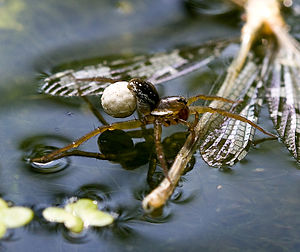Pirate spiders
| Pirate spiders | ||||||||||||
|---|---|---|---|---|---|---|---|---|---|---|---|---|

Pirata sp. (Female with cocoon) |
||||||||||||
| Systematics | ||||||||||||
|
||||||||||||
| Scientific name | ||||||||||||
| Pirata | ||||||||||||
| Sundevall , 1833 |
The pirate spiders ( Pirata ) are a genus from the family of the wolf spiders (Lycosidae). Most pirate spider species are up to one centimeter in size and thus belong to the small to medium-sized wolf spiders in Central Europe .
Mark
The pirate spider species typically have a light central band on the head chest ( carapace ), which includes a fork-like mark in a darker shade. With darker shapes, this pattern can be difficult to distinguish.
Way of life
All pirate spiders colonize moist habitats, especially the banks of various bodies of water, but also swampy meadows and moist to wet areas of moss. They are able to skilfully walk over the surface of the water by taking advantage of the membrane created by the surface tension. On the other hand, they can also pierce and submerge this surface membrane. In doing so, they take air with them under the surface of the water with the felt of their abdomen and can thus stay under water for some time. On the surface of the water they hunt for small insects that have flown in or have crashed there, but also for insect larvae that hang below the surface. They also track small crustaceans and water lice underwater , which they eat outside of the water. When hunting, they orientate themselves visually on the movement stimuli of their prey. The species build vertical tubes in moss or soft ground, which they use as a retreat. However, most of the time they are outdoors.
Reproduction
As with all wolf spiders, the female weaves a waterproof silk cocoon in which she lays the eggs and which she then carries with her, adhering to the spinnerets, and defends it. This form of brood care protects the offspring from harmful environmental influences and from enemies. Females of P. piraticus expose the cocoon at the openings of their living tubes when the sun is shining . After hatching, the young remain on the mother's abdomen and are carried around until the first molt. This form of brood care is widespread among wolf spiders.
Selected species
In Europe, the genus is represented by three species. The following species occur in Central Europe :
- Pirata piraticus ( Clerck , 1757)
- Pirata piscatorius ( Clerck , 1757)
- Pirata tenuitarsis Simon , 1876
Web links
- Pirata in the World Spider Catalog
literature
- Heiko Bellmann: Cosmos Atlas Arachnids of Europe . 3rd edition Kosmos, Stuttgart 2006, ISBN 978-3-440-10746-1
- Barbara Baehr, Martin Baehr: Which spider is that? Kosmos-Verlag, Stuttgart 2002, ISBN 3-440-09210-0
Individual evidence
- ↑ Barbara Baehr, Martin Baehr: Which spider is that? P. 108 ff.
- ↑ Barbara Baehr, Martin Baehr: Which spider is that? Kosmos-Verlag, Stuttgart 2002, ISBN 3-440-09210-0
- ↑ Gettmann 1976, cit. in R. Foelix: Biology of the Spiders ; Thieme Vlg., Stuttgart 1992, p. 170
- ^ Spiders of Europe and Greenland
- ^ R. Foelix: Biology of the spiders ; Thieme Vlg., Stuttgart 1992, p. 249
- ^ Arachnological Society (2016): Atlas of the Arachnids of Europe, accessed from http://atlas.arages.de on November 10, 2016